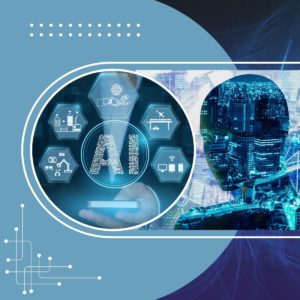AI Solutions for Your Company! – Diagnosis and Workshop
Artificial intelligence, with its versatile applications, has become the subject of intense discussions, debates, and speculations. Many messages warn about its risks, which is justified; however, we encourage looking at the bright, practical side of AI, as it offers increasingly fantastic possibilities. It is crucial to correctly diagnose areas within the company where artificial intelligence can be the most effective tool and provide the most benefits.
Therefore, before moving to specific actions, we propose a thematic DIAGNOSIS and WORKSHOP to identify the potential for implementing AI in your company. This involves analyzing specific areas of your company for the application of AI solutions. This will allow us to create a dedicated roadmap of possible solutions, which we can then parameterize and choose to implement the elements with the highest efficiency-to-cost ratio.
The diagnosis and implementation process consists of seven steps:
- DIAGNOSIS of the approach to AI solutions in the company and its readiness for such solutions – interviews with key personnel.
- AUDIT of activities and processes in the company utilizing digitalization and automation, including methods of data collection, storage, processing, and usage.
- WORKSHOP – exploring potential areas for support and optimization through AI.
- EVALUATION and identification of potential, i.e., defining the area(s) that can benefit the most from AI modules, such as personalization, demand prediction for production, forecasting demand/sales, assortment management optimization, improving business process efficiency, financial risk estimation, multi-layered customer segmentation, active management of marketing campaigns, dynamic pricing adjustments, sentiment analysis, lead generation, efficient personnel management in networks, exploring development opportunities within the industry and market using predictive models.
- SELECTION OF A SOLUTION and preparation of a framework for implementation.
- PREPARATION OF THE MODEL – collecting and preparing data required for model training in the selected domain, training sample models, measuring their effectiveness, and fine-tuning parameters. Presentation of a functioning AI algorithm “proof of concept” for the selected problem, along with data visualization tailored to the client’s needs.
- IMPLEMENTATION of the solution in the company and continuous expert support.
How does it work? Example for prediction processes:
- We start by defining what should be the system’s input, analyzing the company’s statistical data as well as publicly available data. Together with defining the variables affecting the outcome, this forms the basis for problem analysis.
- Next, data processing, which involves extracting key information from input data and modifying it appropriately using data processing algorithms. At this stage, data is automatically cleaned and formatted for AI models and algorithms.
- Building the prediction algorithm involves performing a series of automated analyses using selected and configured AI algorithms, such as advanced deep neural networks (DNNs) or traditional genetic algorithms (GAs).
- The system uses a new AI-based simulation model designed to estimate a defined value or variable, such as product price or cost, based on predefined features. Combined with metaheuristic algorithms, this creates a self-inferencing system to optimize the problem and incorporate it into the decision-making process.
- System output, providing several optimal solution proposals with predicted certainty levels.
- We utilize our universal Data InsAIght module to support decision-making processes through simulations and optimizers based on artificial intelligence algorithms.
DNNs – deep neural networks – networks inspired by the functioning of the human brain, basing their inference on units called neurons. Widely used in classification problems, natural language processing, prediction, and data analysis.
GAs – genetic algorithms – inspired by natural phenomena such as evolution, swarm principles, or herd behavior. Used to find solutions to optimization problems close to the best in relatively short timeframes (a subset of metaheuristic algorithms).
System Description – Data InsAIght:
- The system is cloud-based, allowing easy and fast access.
- Access is provided through a simple web interface, saving time needed for implementation and adaptation to company systems.
- The system is trained on both company-specific and publicly available data from the entire business environment (e.g., government statistics, industry institutions, dedicated reports, available forecasts, and internet-derived potential).
- The system is modularly designed, enabling easy addition of new components and modification of existing ones.


